|
|
 |
This page is dedicated to highlighting some trains
and other items in my personal collection. These items
were collected over several years. Many are quite
rare and even unique. In general, my collection focuses
on western Tokyo (Shibuya, Shinjuku, etc.) trains.
However, there are also a few items that don't necessarily
belong there, but I like anyway. If you're interested
in obtaining any of these or like items, first, please
first see my eBay auctions.. you may find something
there that is similar. Otherwise, please contact me.
Please note that such custom items can be quite expensive
and hard to find.
Looking for items for purchase or to inspire your
own personal collection? Visit the Model
Train Gallery pages for items that I more typically
have for sale.
|
| Western
Tokyo Private Lines: Odakyu Electric Railways |
|
 |
Tomix Odakyu 7000LSE "Romance
Car" Articulated Set
This is an 11-car set of Odakyu
Electric Railway's 7000LSE. It is an articulated
trainset, with cars sharing bogies in the style of
the TGV, which is fairly unique for Japan. The private
Odakyu railways always have a flagship train that
runs the length of its route from Shinjuku to weekenders'
destinations such as Odawara, Enoshima, and Hakone-Yumoto
- this train is given the moniker "Romance Car"
and commands a limited express surcharge atop the
regular fare. The 7000 series I believe was active
through the 1980s. It is an 11-car trainset in the
"classic" romance train scheme of off-orange
and off-brown that initially may look a bit weird,
but is actually quite nice when you warm up to it
a bit. The 7000LSE was also later in its career painted
red and white.
Alas, more recent incarnations of the Romance train
have been far more forgettable,
sporting generic liveries that make them no better
than generic JR affairs (that link is actually quite
clickable as it shows how Odakyu tries to sell the
train as a "Romance" train, even though
in practice it is generally filled with salarymen
off for a picnic). Here is the complete list of "Romance
Cars" (note the 7000LSE in this illustration
is shown in the red-white scheme)

The Tomix model is a bit old. Hard, but not impossible
to find these days on the secondary market. Tomix
and Kato both make the OER10000 HiSE, which was the
upate train to this in a red and white livery (also
nice). I occasionally sell these on eBay (the Kato
ones tend to be quite rare indeed and a lot more expensive
than the Tomix ones here) as they really are nice
sets. My 7000LSE comes in an older-style Tomix folio
case. I have the destination stickers set for Hakone.
My OER 7000LSE is Tomix #92009.
UPDATE! I have since gone on a spree of Romance Car train acquisition. I now have in my collection:
- MicroAce 3000 (SE) - both the original 8 car version (MA-2151) and the heavily modified 5-car version
- MicroAce 3100 (NSE) - This was released by MicroAce in three versions. I have the "Sayonara 3100" version
- Tomix 7000 (old colour scheme) as mentioned above
- 10000 - I don't own one, but at any given moment I have one here for sale. Please let me know if you are interested, as I have some really nice ones.
- Modemo 20000 RSE. For a VERY brief period, Modemo (of all manufactureres!) released a 20000 Romance Car version. Who would have guessed that tram-maker Modemo would do such a thing! At any rate, it is a very fine model. Very hard to find now.
- Tomix 50000 VSE. Really really superb bit of kit. One of Tomix's finest. I bought one when they were new, and sold quite a few more. Borderline impossible to find now.
I have no particular interest in the 30000. It is a rather boring train by any standard. My Romance Car collection, I am happy to say, is enviable even by Japan standards. If you are interested in any of these trains, I can try to help.
|
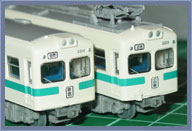 |
TomyTek Odakyu 2200-series (Highly Modified)
In 2006, Tomy, as part of their TomyTek "collections" series issued a "commuter trains of the past" collection of N gauge items. Not nearly to the standard of Kato, MicroAce, and Tomix "professional" N gauge items, the TomyTek trains were meant to be sold in convenience stores and were made of a thicker, inferior plastic all-over, including bogies, wheels, and pantographs. When one purchases a box from this collection at the convenience store, one does not know which one of 6 different train cars will be found. I bought this 2-car set from a store in Tokyo which opened the boxes, paired up the natural pairs, and sold them at a marked-up price. The most highly marked up (except for a special limited edition "secret" pair), and therefore the most popular was this Odakyu 2200-series set, consisting of trailer cars 2213 (with pantograph) and 2214 (without). Now, I say that the quality of this is not as good as, say, Kato. That is true. However, even this convenience store toy stuff compares favorably to stuff by, say, Graham Farish! Or, at least the body shell itself did. Having no interest in running this as a motorized set, I set about making it look as good as it can for non-moving (static) display opeartions. I modified this by:
- Removing the generic heavy plastic pantograph and replacing it with a quality GreenMax one from my spares collection. Thoughfully, TomyTek had anticipated that some
enthusiasts might want to do this and included pre-drilled slots for either GreenMax or Tomix replacement pantos.
- Replacing the plastic bogies with quality GreenMax replacements. I used the OdakyuFS wheelsets - I am not sure if these ar ecorrect for the 2200 series, but
it's probably good enough (note the photos here still shows the old wheelset)
- Replacing the coplers between the cars with Kato hose-type couplers. That said, this set may be a candidate for further upgrade to Tomix TN-style couplers
- Adding service and destination stickers from GreenMax's Odakyu sticker set. I put Odawara on one end and Shinjuku on the other. Not exactly realistic (a real train would have the same destination on both ends), but good enough for model purposes.
- I toyed with the idea of upgrading the lights as well, but so far have chickened out. I do have some miscallaneous pieces from a brass kit that could do the trick, but i worry about ruining it. Also, the painted-on lights aren't that bad, I think. The silver headlights in particular look basically correct, though the 'silver taillights' might need an upgrade at some point.
The overall result is good. Fortunately, I had a lot of the required things (including the stickers) in my spare parts bin (though I did buy the bogies especially for this).
|
 |
MicroAce 4000-series Odakyu
Commuter
A good match to run with the Romance
Cars, this is a very typical Odakyu Commuter set. This
is a 2005 release by MicroAce, and pretty much the best
model from them that I have seen, further evidencing
that the quality from them continues to imrpove. This
is a 6-car set that I had to pay quite a bit above the
odds for to get as it had rapidly sold out in Japan.
I am still looking for a similar Odakyu 2600 set. |
 |
Chiyoda Line / Joban Line 103-class
I saw this train for sale in Tokyo and
was amazed at the bargain I thought I was getting...
and then I found out why. Still, I'm not at all unhappy
with it. Let me tell you why. First, this is a train
by Win. Not Kato, not Tomix, but "Win", which
ranks about tenth in the list of Japanese model train
manufacturers (a list where, if you're already at 5
or 6 you're already pretty obscure). I think this started
its life as a kit (at least a pre-painted one), but
I am not sure. Anyway, this is a Chiyoda (subway) line
/ Joban Line 103 series train, with decals making it bound for Yoyogi-Uehara.
Now, you might recognize that a 103 series is not a
subway train. Rather this was the standard JNR (Japan
National Railways, pre-privatization into JR) commuter-train.
Why then a Chiyoda line 103? Because these trains ran through the Chiyoda line on one end onto the JNR/JR
Joban line and on the other on the (private) westenr-tokyo
Odakyu line. So, it's an interesting mix of JR, subway,
and western-tokyo private line all in one train. It's
also interesting in that they decided to keep the "JNR"
logo on this train well into the post-privatization
days. Anyway.. about that bargain - the reason I found
it cheap probably had to do with the fact that MicroAce
had, unbeknownst to me, just put out a manufactuerd
(not kit built) version of this set. Pity - manufactured
versions tend to be quite good in Japan, no matter how
good the kit-builder. Additionally, the manufactured
set would feature working headlights and taillights,where
this had none. Still, the detail on this Win set was
not bad, and I got it quite cheap. The set I got was
unmotorized - I found a Kato 103 ("canary yellow")
motor car and transferred the motor to this set (the
motor fit in with suprising snugness - I don't think
I could do it again, but after some work including a
bit of filing, the fit is perfect!). If I have time,
I may try to add headlights and taillights to this,
as, even with my general lack of skill for such things,
this looks doable. Update: I hae replaced
the couplers on this with proper ones and have ordered
the parts necessary to install working headlghts. Let's
see how this turns out! |
 |
Chiyoda Line / Joban Line 203-class
The 103 above was a bit of a stretch for me. Lo and behold a MicroAce Chiyoda / Joban 203 series fell into my lap. The 203 is the successor to the 103. MicroAce made this in two versions - one with the JNR logo on the front and one with the newer JR logo. Alas, I got the JR version. |
| Western
Tokyo Private Lines: Keio Electric Railways |
|
|
|
 |
Keio 5000 series
This is an extremely well built GM kit
of a classic Keio train. The 5000 is sadly now retired
from all Keio services (though it continues to run elsewhere,
repainted). I purchased this set of 8 from an expert
builder who clearly spent a lot of time detailing it.
It even includes a good number of N-scale passengers
inside (note the driver in the cab). I am extremely
fortunate to have found this set. The 5000 is a great
looking train - given the success they have had with
recent not terribly dissimilar Odakyu releases, maybe
MA might care to release this one... |
 |
Keio 6000 series (old
livery)
My favorite train! The Keio 6000 is
my favorite train for some reason (well, I did used
to take it to school every day). To most people, this
is a pretty run of the mill commuter train, but , you
know, everybody is entitled to their favourite. Unfortunately,
the train is not available in a mass-produced set (yet..
I have my fingers crossed that MicroAce might someday!).
So, for now, this is a GreenMax kit-built 4-car set
(with decals attached as a tokkyu / superexpress bound
for Shinjuku) Unfortunately, this kit was built by me,
meaning that, despite my best efforts, it is not exactly
the pinnacle of the model-maker's art. Note that the
red stripe you see here is the older Keio livery - I
also have this kit (as yet mercifully unbuilt) in the
newer, blue-and-pink (ugh) stripe livery. If you are
a quality builder of plastic kits (sorry - I should
have made it more clear - it is an unbuilt kit, but
pre-painted - this is not to say it wont need more paint,
but the basic stripe and background colour is done)
and would like a go at my 4-car set, I may be very receptive
and am willing to pay a fair sum or trade for some trains... |
|
|
 |
Keio 1000 Series (Inokashira
Line) Commuter
Mostly for sentimental reasons, Keio is my favorite
railway operating company in Japan, and I try to collect
as much Keio as comes out. Fortunately for my girlfriend,
as yet there have been precious few Keio releases
by the major manufacturers - none, in fact, by either
Kato or Tomix. There are a few reasons for this -
one, Keio, while on paper Keio is a largish company,
it's a bit smaller than some of the other private
railway companies. Two, for the most part no Keio
lines really run adjacent to any major JR lines, so
it's not a natural fit (compared, to say, Keikyu)
to those who are modeling some JR-infested area anyway.
Three, while it pains me to admit this, Keio trains
probably aren't objectively as sexy as those of some
similar companies--evidence #1 to this is the Odakyu
Romance train elsewhere on this page.
The closest that Keio has to "sexy" trains
are the colorful trains of the Keio Inokashira line.
Each Inokashira line train has a different colour
front and associated stripe. This is a 1000-series
Inokashira train in "salmon pink" - the
same train exists in blue, green, purple, cream, and
a whole host of other colours. If you're standing
on a platform waiting for a train, you can make bets
with your friends as to what colour you will get.
Inokashira trains always run as a 5-car set.
Anyway, this train is from MicroAce - that's right
- an actual (as yet the actual) manufactured trainset
of Keio by a major company (well, ok - to be fair,
Endou and a few other now obscurish companies put
out a few Keio trains in the 80s). Hooray! Hopefully
it will be the first of many. As you can see, I have
not yet put the decals on. It's a nice set-- the feel
of the MicroAce trains is a little different than
that of Kato and Tomix, but once you get used to it
you will recognize their quality in their own right.
Interestingly, the 1000-series are the newest Inokashira
trains. They replaced the 3000 series (don't ask me
how that worked...)
|
 |
Keio 3000 Series (Inokashira
Line) Commuter
I was lucky here to find a well-built
3000-series Inokashira line train. This 5-car set came
to me built out of a GreenMax kit. Whoever did it did
a competent job. It's well built and the decals competently
applied, including the Shibuya destination sign (we
assume here that it's a local train - an express would
have had a red mark on the front). In the absence of
manufactured kits, sets, this is about as well as you
can do for the Keio 3000, which, after all, was the
classic Inokashira train. If you're a betting person,
you might bet that this train will be manufacturered
(by MicroAce?) before too long. These trains, now retired
from Keio services, now serve on a number of secondary
lines. The 1000 served in a variety of colours - my
one here, as you can see, is in a lovely puke green. |
 |
Keio 3000 Series "Renewed
Design" (Inokashira Line) Commuter
You might notice that this 3000-series
train looks something between the above 1000 and 3000
series. Actually, what this is that at some point towards
the end of the Classic 1000-series service life, they
decided to upgrade the look of a few of them to the
more "modern" look shown here. This is a 5-car
series put out by Yuzawaya, a relatively obscure manufacturer.
The quality is about the same as that of the well-made
GM-kit above, and, while I am not sure of this, it is
possible that Yuzawaya's offerings are simply "professionally"
built GM-kits - there are a few companies doing this
sort of thing. As I wrote above, Inokashira trains come
in a variety of colours. Alas, I had already purchased
the MA 1000 in salmon pink when this one came along.
Yuzawaya sets are generally quite dear, and this one
came along rather inexpensive, so despite it unfortunately
doubling me up on pink sets, I went for it. If anybody
has a non-pink MA 1000 that they'd like to trade for
mine, please do let me know! |
| Western
Tokyo Private Lines: Tokyu Group Railways |
|
 |
Gakunan Railway (ex-Tokyu)
Set
This train, a 5000-series, is known
as "Akagaeru", which I believe is the name
for some sort of toad or frog. Currently, this 2-unit
set runs on the Gakunan
Railway, a tiny little thing in Shizuoka prefecture
that is interesting enough on its own. However, my interest
in this set is less for its present than for its past,
where it used to run (as a five car set, I believe)
on the various western Tokyo Tokyu lines. This is a
two-unit motorized set from MicroAce. Alas, I managed
to bang up one of the pantographs on this a bit, so
its due for repair. Interestingly, Tomix also released
this train (in that case, as a Tokyu 5000-series) as
a limited-edition set in 2002. The price for that set
was quite high, so I gave that a miss - I am quite happy
with this inexpensive yet attractive set as a replacement!
On the real Gakunan Railway (part of the Fujikyu group),
I think this set now runs in red livery with a white
stripe. The Gakunan railway, incidentally, is a superb
choice for a small Japanese layout. If you're a fan
of the free Japanese Railway simulator BVE,
please be aware that there is a free Gakunan
Railway available for download. |
 |
Tokyu 8500 Series Commuter
This is a 4-car GreenMax built-kit,
well made of an 8500 series commuter EMU. Markings are
of an express bound for Nagatsuda. I used to ride this
train often to school back around 1984. They are still
in service on the Tokyu Den-en-chofu (ex Shin-Tamagawa)
and perhaps some other lines. |
 |
Modemo Tokyu DeHa80 Tamaden
(text to be written) |
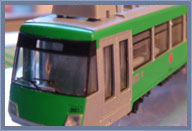 |
Tokyu 300 'Setagaya Line'
(text to be written) |
| Western
Tokyo Private Lines: Seibu Group Railways |
|

 |
Kato Seibu 101 and 301
series
These are probably my favourite Kato sets of all
time. Way back when, Kato released their 101 series
set. Those quickly sold out and were heavily in demand
in the aftermarket for some time. Only after intense
searching did I manage to find a 4-car unpowered set
of this. Then, several years after that, Kato must
have woken up and realized how popular this set is,
and they re-releaed it, though with some differences.
Now please excuse me if I get this wrong, because
it's quite confusing, to say the least! Basically
there are two types of trains: ones like you see at
left and another type with a bronze stripe running
the length and height of the windows. The old 101
set that was sold had the bronze stripe and was just
sold as the "101". Now, there is a "101
new colour" (pictured at left) which does not
have the bronze stripe. However, the "301 old
colour" does have the bronze stripe. The 301
and 101 are nearly identical in terms of the model,
though the new version has been updated with nicer
couplers. This begs the question: what is the difference
between the "old" 101 and the "301
old colour?" Well, I have both - and except for
road numbers and tiny little details that are tiny
even by the standards of nitpicky Japanese hobbyists,
there are none.
How many of this train do I own? I am a bit embarassed
to say. "Too many" might be the answer.
I think in total I own about 26 cars of this type,
including 10 end cars and 5 motorized cars (the sets
were sold in 2, 4, 8, and 10 packs.. I have a bunch
of them.. I've never really counted). Due to the way
these things were sold, some of the motorized cars
are end-cars and some are middle cars.
So why do I like this set? Well, for one, I like
western tokyo private lines, and the Seibu company
certainly is a nice example of this. Second, I used
to ride a Seibu train daily while in Japan, and, for
a long time, this was the closest thing to this. Actually,
the train I used to ride was a 101-set with a similar
paint scheme to the "new" 101 pictured above,
but with a different cab configuration. Fortunately,
MicroAce is about to release a 701 series which basically
looks like the 101 with the old cab configuration.
Confused yet? Bored? I understand.
Anyway, it's a nice looking train. A happy yellow
colour and a good runner. I occasionally sell these
on eBay - why not have a look?
|
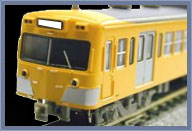
|
MicroAce Seibu 701 Series
As hinted at above, MicroAce did eventually release the 701 Seibu EMU. A decent set by western standards. Seibu has a whole series of similar trains (old cab style 101, 501, etc) that are virtually indistinguishable from this 701.
|

|
Seibu E851 Locomotive
This is a really good Locomotive by Kato. I occasionally
sell these on eBay. Basically, this is a Seibu E851,
which is really a standard EF65 loco that the Seibu
company dolled up a bit cosmetically in a very un-JR-like
livery and added some round windows on the sides.
|
| Western
Tokyo-area JR Railways |
|
 |
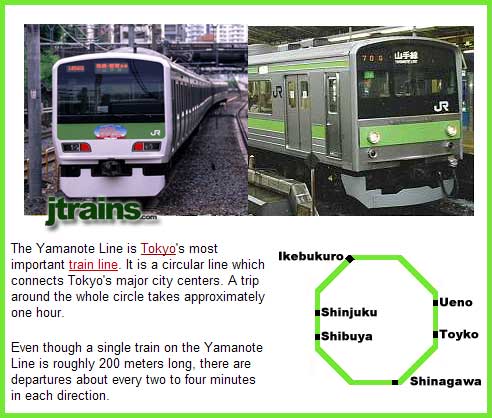
|
 |
Kato JNR 103 Series Yamanote
Line Commuter ("High Cab ATC type")
You can't live.. forget live.. be in
Tokyo very long without knowing about the Yamanote line.
It is the train line that literally defines Tokyo -
not just geographically, but socially and culturally
as well. This 103 series train was the very first N-gauge
Japnese train that I bought - in about 1987, I think.
It represents the then current, now retired to the Hachioji-line-and-further
afield very classic 103-series Yamanote line series.
Amazingly, this Kato set still runs absolutely perfectly
today. |
 |
Kato JR East 205 Series
Yamanote Line Commuter
The 103 was replaced by the 205 on Yamanote services.
Though the 205s are now (2005) being mostly phased
out, this was the de-facto Tokyo commuter throughout
the 1990s. This is a Kato set.
Update: since the photo at left was taken,
I have added the extra detail pieces and have painstakingly
added the stickers / decals for this train. It looks
great now!
|
 |
MicroAce JR East E231Series
Yamanote Line Commuter
The 205s are now being phased out in
favor of the E231s. These are arguably the most advanced
commuter trains in the world in many respects - super
lightweight construction and all manner of technical
innovations, including smart video displays over every
(or most) doors and much more. This is a set from MicroAce.
Kato and Tomix also make this E231, but I happened upon
this MA set at a good price, so I went for it. |
|
Other
Tokyo and Shitamachi (East-Tokyo, including Tokyo
station) JR |
|


|
Keihin-Tohoku Line 209
Series
I had always wanted a Keihin-Tohoku 209. This 4-car
set came to me in a parcel of items ordinarily destined
for eBay, but when I saw it and its internal lights,
I just had to have it. Below is some information on
the Keihin-Tohoku line:
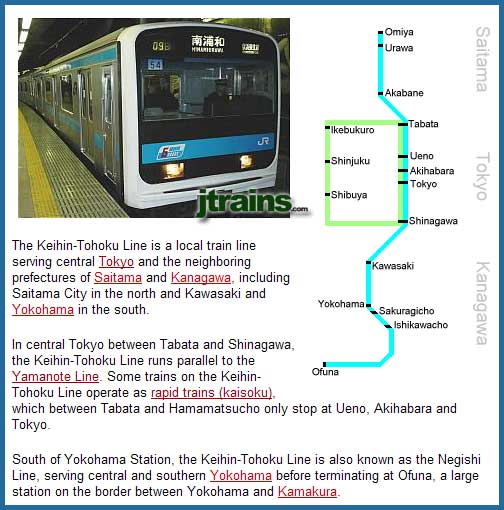
Mine is a Tomix 4-car set (one car motorized).
The current destination headboard on each side is
that of a rapid train ("kaisoku") bound
for Omiya, though I may change this out to Sakuragicho
at some time in the future. My attachment to this?
My familiy used to live briefly near Tamachi station
which is served by the Yamanote and Keihin-Tohoku
lines.
|


|
113-1500 Series ("Yokosuka
Line Colour") Long-distance Semi-Fast EMU
This is an 8-car set (Kato 10-195) of
the Yokosuka line. I bought this some time ago, new.
It is an attractive train, I think. These sets are very very very hard to find now, for whatever reason. |
 |
Kato 153-series "Shin
Kaisoku" EMU
Ok, this is a bit of a fib to say that
this train really is an Eaat Tokyo train, and probably
it more fairly belongs in the "et Cetera"
section, but maybe if I hide it here, I am spared some
wrath of significant other. This is a 153-series shin-kaisoku
train that I added to my collection simply because I
found the model to be suprisingly attractive. The prototype
(with the Shin-Kaisoku marque at front) travels around
Kyoto. There is a Kyuuko (express) version that travels
from Tokyo station using a different Marque ("Tohoku"),
but i have not had the opportunity to affix this as
yet. |
 |
Kato EF58-61 Locomotive
This is an Imperial locomotive that
I nevertheless use for general use. A nice flywhele
model from Kato with very good detail. I did not add
the Japanese flags to the front that imperial use usually
entails. As opposed to some of the other trains that
you see here, this train does already have its full
complement of detail and decals attached, and you can
see from the photo that it looks better than some here
because of it. |


|
Chuo
Line, Including "Azusa" Services |
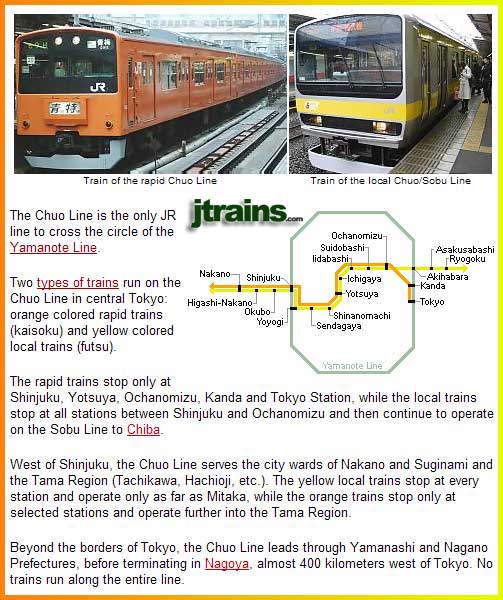
please
note that the above text (in the box), while factually
accurate, is rather incomplete and perhaps a bit misleading
(I took it from another site). I will try to update
it when I can. |
 |
MicroAce JR East 231-series
Series Sobu Line Commuter
(text to be written) |
 |
Kato JR East 201 Series
Chuo Line Commuter
One of my absolute favorite trains, I now own two 6-car sets of these. See the above Chuo line description for an idea. |
 |
JR (JNR) 169-series "Mitaka
Line"
Often involved in 'Relay-Go' services on the Chuo-line, this is a pretty nifty train. You should know that this is part of Tomx's HG (high grade) series, and the difference shows. These things cost about twice as much as Tomix's normal (and already not cheap) sets. I fortunate to find this unit for sale secondhand in basically new condition, but that's not the whole story. This 165/169 series train is sold by Tomix as a 3-car main set and a 3-car add-on. It was clear from the price that I got this for that the store that sold this to me didn't realize that the add-on was included in this box that I got here - somehow they mis-priced this much to my advantage. Yay! I have added LED bright internal white lights to this. |
 |
183-1000 Series Limited
Express EMU ("Azusa")
A true classic. This is the 183-1000
in classic JNR colors. This much beloved train still
runs today in the same livery, in a manner of speaking.
The "Chuo Liner" still runs the same route
in the same classic JNR colours, even though JNR has
long been privatized into various JR companies. Kato
sells a seperate "Chuo Liner" version of this,
but I prefer this - it allows me to selelct the traditional
"Azusa" headboard (along with Toki, and a
few others). For some odd reason, I have the main set,
which I think is 6 or 7 cars or so, and FIVE 2-car add-on
sets, which is actually more than necessary to complete
a prototype train. So, if you are in need of add-ons
for this, please contact me. |
 |
189 Series Limited Express
EMU ("Azusa New Color")
Sometimes even a blind pig finds a truffle.
I was really marginal about buying this Kato set when
it first came out. Yes, it ran on my favorite Chuo service,
and yes, I had riden on it a few times in real life.
But enough to purchase it? Fortunately, i did. Not only
have I come to really like the train for its livery
(aesthetically it is quite similar to the 183-1000),
but for some reason this has become one of the rarer
and most sought-after Kato releases and has MASSIVELY
increased in price on the aftermarket. Not that the
price increase really matters that much to me - I am
not going to sell this, after all, though it makes me
feel good, I guess. A really nice train. |
 |
Kato E351 Super Azusa
Pendulum Train
With the gradual phasing out of service
of trains such as the 183 and 189 above (or, at least
reduction in frequency of their use), plans were made
for new trains to ride the "long distance"
Chuo line route. Enter this Super Azusa pendulum train.
It is a model from Kato and actually features "pendulum"
action by means of castering bogies. A nice effect and
a very modern looking train - always gets some comment
from people who have not seen this sort of thing before. |
|
Shinkansen
/ Bullet Trains |
|
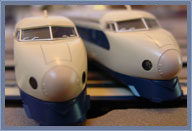 |
0-series Shinkansen
This is the one train that, to many people, is Japanese trains. This is the original 0-series bullet train. A must have in the collection of any Japanese train enthusiast, and, really, almost any N gauge enthusiast. These are available from Kato, Tomix, and MicroAce in many small variation. Mine is a Tomix manufacturered set commemorating the last run of the 0 series on the Tokaido shinkansen (but generally speaking, an ordinary Tomix set). |
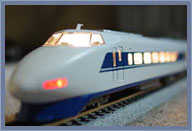 |
100-series Shinkansen
/ Bullet Train "Grand Hikari"
Kato 100-series "Shark Nosed"
Shinkansen. This was modified with (high quality) Kato
LED internal lighting and also the decals were very
competently attached. All in all, a very nice train.
That said, I may use this train for one of my pet projects,
which is the installation of small switches to allow
the internal lighting to be shut off. It's not that
hard of a technical problem on most of the cars, but
on the motor car and end-cars (which also have directional
lighting), it could be quite a bit trickier. |
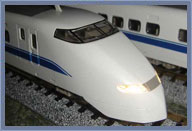 |
300-series Shinkansen
/ Bullet Train
Pity the poor 300! Not unloved, just ignored. The 300 is a workhorse of the Tokaido line and by most measures a darn good train. However, it's oafish "darth vader" appearance has just never made it a fan favorite. It's the Airbus A330 of the shinkansen world, if you will. A few fellow enthusiasts asked me for this model, and after much searching I procured a few examples. This gave me time to look it over and I decided it was a very good model. I decided to keep one, and I can't say that I'm dissatisfied with my decision. |
 |
500-series Shinkansen
/ Bullet Train "Nozomi"
Perhaps the fastest looking
train ever, this is also the fastest driving regular
shinkansen. My set is by Kato. I purchased an excellent
quality secondhand 7-car set whose previous owner had
competently appled a "wash" to the panels
on the bottom to make the detail really stand out on
this unit. |
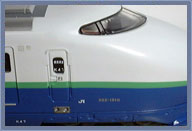 |
MicroAce 200-Series "Renewed Livery" Shinkansen
(text to be written) |
 |
Tomix E3 "Komachi" Shinkansen
(text to be written) |
 |
Tomix E4 "Max" Shinkansen
(text to be written) |
|
 |
Tomix Meitetsu (Nagoya
Railway) 7000 Series
I always kind of liked this train after "driving"
it in Densha de Go, Nagoya Tetsudou, a computer (or
PlayStation) game where you simulate driving trains.
Still, in the spirit of "focusing" my collection
on my primary like of western-Tokyo trains, I never
thought I'd get this. At one point, I received a set
of this from Japan for sale on eBay. After quite a
number of tries, it eventually sold. This gave me
ample time to look at the model and I decided that
I liked it. Later, another arrived from Japan. I posted
it a few more times - no bites. Finally, I mumbled
something to myself about people not recognizing just
how difficult it is to obtain this out of production
set, and decided to keep it for myself. There. I'm
happy.
The miscalculation was probably mine - I thought
it would kind of appeal aesthetically to people more.
To me, it reminds me of some of the trains I saw in
Rome's Termini station. Meitetsu is a private railway
company based around Nagoya that probably has more
audacity in its train designs than all the JR companies
combined. Some of their designs, like this one, work.
Others, don't.. but they always try (though truth
be told I haven't heard of a new Meitetsu train in
quite some time, though maybe I just didn't notice.
It wouldn't surprise me if the bean counters have
taken over and the era of cool designs where you carry
a ton of chrome just because you can is over, but
I digress..).
The photo at right is actually of the first set I
sold. Mine is essentially similar, but the end marks
have been installed. It should be mentioned that this
train is also only four cars long (though I think
the prototype can be up to six.) This is Tomix #92046.
Because of the slow demand the last time I sold this
(slow demand that I was frustrated with, because I
thought it was a much better train than the public
seems to think so, and my price was already very low
on it), it seems unlikely that I will bring more in
unless we happen to find one for a song (unlikely
- there is still relatively strong demand in Japan
for this on the aftermarket), so if you want one,
please contact me seperately.
|
 |
Kato KiHa82 6-Car DMU
I think this is my lone diesel amongst
all the electrics. This is a very classic Japanese train.
This is the newest version, from Kato, sold as a technology
demonstrator of sorts to showcase all of Kato's latest
technologies, including: a particularly small sized
flywheel motor (note: my flywheel action is, I would
say, poor. I have Kato locos with flywheels and they
are excellent, but this I have been less than thrilled
with), DCC-readiness (for some hypothetical future Kato
DCC plug-in decoder), A special suspension, special
new close couplers, and more. There have been plenty
of KiHa 82 sets over the years, some of which are of
poor quality. I wanted the state of the art, and this
was it, though the set is not quite as nice as I thought
it would be given all of Kato's hype around it. This
set doesn't really fit my prototype that well - this
DMU theoretically could be seen around Ueno, but even
that is a stretch for me. |
 |
Tomix Usui-Toge Dual EF63
Locomotive Set
This set of two locomotives (one powered,
one not) does not really match my usual prototype. However,
I ran accross this and decided that I had to have it.
The EF63 is generally a pretty generic loco, not too
different from the more common EF64 and EF65. However,
these EF63s come from Tomix's HG (High Grade) series,
and so features considerably more detail than regular
locos. This twin loco set (recently retired) also has
an interesting history - they were used to help passenger
trains (including 183-class "Grade Up Asamas")
through what is arguably Japan's most well-known section
of non-shinkansen track - the Usui-Toge section of the
Shin-Etsu line. It's actually a pretty interesting story
- you can read more about the Usui-Toge line in a good
article in English at JRTR.
Additional information and photos at Yokokawa's
homepage (English) and Usui-Toge.com
(Japanese). Additionally, this route was the subject
of an add-on
for Microsoft Train Simulator. One of the locos
in this set is powered and one is a trailer. The inter-loco
coupling mechanism is highly unique. Tomix #92125. This
item is out of production in Japan, though it can be
found with a good bit of searching. |
 |
The Bus Collection Tokyo
Municipal Buses
In the last few years, there has sprung
up what some might consider weird, even by the generally
quite, umm, accepting standards of model railroading.
A whole line of N-scale buses have gone on sale in Japan
under the name "The Bus Collection." These
(made by Tomy, just like Tomix) are really well detailed
buses, but ultimately that's it - no lights or motors
as in model trains. They're just little plastic buses
about two or three inches long. From this you might
guess vaguely how much these things cost - you know..
a little more than the N-gauge cars and trucks that
you've seen whever you've seen them since these buses
seem to be more detailed, but not too much more so.
Well, you'd be suprised. These buses are expensive -
they cost even more than some train sets! In some cases,
individual buses cost more than 20 pounds! Fortunately,
I found this set of five Toei (Tokyo Municipal Government)
buses pretty cheap (on deep discount, actually) and
so I added them to my collection for some theoretical
layout that I might someday build. I think the difference
between us, and, well, the Bus Collection enthusiasts
is that there are apparnetly people for whom collecting
these different buses (and there are a LOT of them!)
is the main activity, not just garnish for trains. Oh,
and don't get me started on "the Truck Collection.."
(Yes, I'm serious..) |
|
 |
|
|
|


